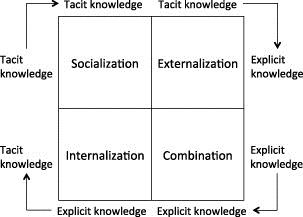Introduction to “The Nonaka and Takeuchi” Knowledge Management Model
The Nonaka and Takeuchi model is one of the knowledge management model that can be used in the knowledge creation and conversion. Knowledge management models itself are the approach to manage knowledge from people and process of an organization. Each organization usually capture, codify, or render tangible and intangible knowledge in the shape that we know as tacit or explicit knowledge. Tacit knowledge is the kind of knowledge which is not written and used only by verbalizing the knowledge. This can lead to difficulties of acceptance for other people because there is no written information that can be used or read over in a long time, only the person who knows about the knowledge can keep it, but it will remain in the mind. In other words, explicit knowledge is the reverse explanation of tacit knowledge. Explicit knowledge is the written type of knowledge that can be used over by other people, but not all knowledge is transferred in a written way. Therefore, The Nonaka and Takeuchi model is one of the model that can represent the conversion of knowledge, whether it is from tacit to explicit or the other way around. Below is the figure of The Nonaka and Takeuchi model:
As we can see from the figure, there are four types of conversion of tacit and explicit knowledge. Below is the explanation of each types along with the example:
- Socialization: it is the process of conversion from tacit to tacit knowledge. As we know, tacit is the unwritten type of knowledge. The most common example is training or sharing face to face. In training or sharing, the knowledge conversion is more natural because it is one of the typical social interactions. From doing this knowledge sharing or training, the knowledge will remain in the participant’s mind, rather than noted elsewhere. This type is more to the process of acquiring it by experiencing the knowledge transmission.
- Externalization: this type is conversing from tacit to explicit knowledge. From the unwritten knowledge, it is conversed to a written knowledge. The example is from someone who has a knowledge and starting to write a book to share the knowledge to many other people, so the knowledge can be tangible and permanent.
- Combination: the next type is conversing from explicit to other explicit knowledge. This type can be interpreted to process of combining explicit knowledge form many sources and finally make a new form of explicit knowledge. The common example is when we are making a report or analysis. We search or gather explicit information about the transactions to make a financial report.
- Internalization: it is the conversion from explicit to tacit knowledge. For this type, the knowledge is shaped in a written type first, then along with the time goes by, the knowledge will spread and become a tacit knowledge. An example for this is in an organization. Organization always has a written rules for the company, but as the time goes by, the rules spread by the employee itself to the other employee and the rules become tacit knowledge because they already have the rules on their own mind.


